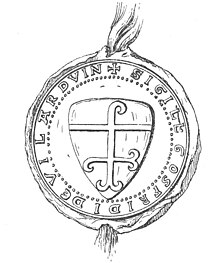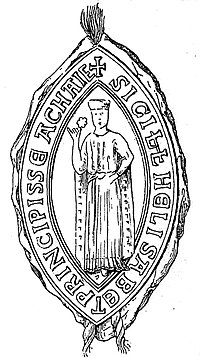Geoffrey I of Villehardouin (French: Geoffroi Ier de Villehardouin) (c. 1169 – c. 1229) was a French knight from the County of Champagne who joined the Fourth Crusade.[1][2][3][4] He participated in the conquest of the Peloponnese and became the second prince of Achaea (1209/1210–c. 1229).[2]
| Geoffrey I Geoffroi Ier | |
|---|---|
| Prince of Achaea | |
 Seal of Geoffrey I | |
| Reign | 1209/1210–c. 1229 |
| Predecessor | William I |
| Successor | Geoffrey II |
| Born | c. 1169 Unknown |
| Died | c. 1229 Unknown |
| Burial | Church of St James, Andravida |
| Spouse | Elisabeth (of Chappes?) |
| Issue | Geoffrey II Alix William II |
| Dynasty | Villehardouin |
| Father | John of Villehardouin |
| Mother | Céline of Briel |

Under his reign, the Principality of Achaea became the direct vassal of the Latin Empire of Constantinople.[5] He extended the borders of his principality.[6]
Early years and the Fourth Crusade
editGeoffrey was the eldest son of Céline of Briel and John of Villehardouin.[2] He married one Elisabeth, who may be Elisabeth of Chappes,[7] a scion of a fellow crusader family, an identification rejected by Longnon.[8]
Conquest of the Peloponnese
editWilliam of Champlitte was prince of Achaea (1205–1209) under the suzerainty of the king of Thessalonica.[9][10] Geoffrey received Kalamata and Messenia as a fief from the new prince.[10]
Reign in Achaea
editIn 1208 William I of Achaea sought to claim an inheritance his brother had left to him.[5][11] However, both the first prince of Achaea and his nephew died.[12]
The Chronicle of the Morea narrates that Geoffrey only became prince of Achaea some time later.[13]
Next the papal legate Cardinal Giovanni Colonna in 1218 excommunicated Geoffrey I.[14] Upon the request of the local high clergy, it was confirmed during 1219.[15]
Geoffrey died sometime between 1228 and 1230.[4] He was buried in the Church of St James in Andravida.
Footnotes
edit- ^ Runciman 1951, p. 126.
- ^ a b c Evergates 2007, p. 246.
- ^ Setton 1976, p. 24.
- ^ a b Longnon 1969, p. 242.
- ^ a b Longnon 1969, p. 239.
- ^ Longnon 1969, p. 240
- ^ Evergates 2007, p. 263.
- ^ Jean Longnon, Les compagnons de Villehardouin (1978), p. 36
- ^ Longnon 1969, p. 237.
- ^ a b Fine 1994, p. 70.
- ^ Setton 1976, p. 33.
- ^ Setton 1976, pp. 33-34.
- ^ Fine 1994, p. 71.
- ^ Setton 1976, pp. 47-48.
- ^ Setton 1976, p. 47.
See also
editReferences
edit- Evergates, Theodore (2007). The Aristocracy in the County of Champagne, 1100-1300. University of Pennsylvania Press. ISBN 978-0-8122-4019-1.
- Fine, John V. A. Jr. (1994) [1987]. The Late Medieval Balkans: A Critical Survey from the Late Twelfth Century to the Ottoman Conquest. Ann Arbor, Michigan: University of Michigan Press. ISBN 0-472-08260-4.
- Longnon, Jean (1969) [1962]. "The Frankish States in Greece, 1204–1311". In Setton, Kenneth M.; Wolff, Robert Lee; Hazard, Harry W. (eds.). A History of the Crusades, Volume II: The Later Crusades, 1189–1311 (Second ed.). Madison, Milwaukee, and London: University of Wisconsin Press. pp. 234–275. ISBN 0-299-04844-6.
- Runciman, Steven (1954). A History of the Crusades, Volume III: The Kingdom of Acre and the Later Crusades. Cambridge: Cambridge University Press.
- Setton, Kenneth M. (1976). The Papacy and the Levant (1204–1571), Volume I: The Thirteenth and Fourteenth Centuries. Philadelphia: The American Philosophical Society. ISBN 0-87169-114-0.
Further reading
edit- Bon, Antoine (1969). La Morée franque. Recherches historiques, topographiques et archéologiques sur la principauté d'Achaïe [The Frankish Morea. Historical, Topographic and Archaeological Studies on the Principality of Achaea] (in French). Paris: De Boccard. OCLC 869621129.
- Bratu, Cristian. “Clerc, Chevalier, Aucteur: The Authorial Personae of French Medieval Historians from the 12th to the 15th centuries.” In Authority and Gender in Medieval and Renaissance Chronicles. Juliana Dresvina and Nicholas Sparks, eds. (Newcastle upon Tyne: Cambridge Scholars Publishing, 2012): 231-259.
- Finley Jr, John H. "Corinth in the Middle Ages." Speculum, Vol. 7, No. 4. (Oct., 1932), pp. 477–499.
- Tozer, H. F. "The Franks in the Peloponnese." The Journal of Hellenic Studies, Vol. 4. (1883), pp. 165–236.